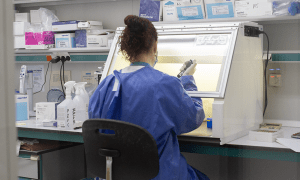A new mouse model allows for more accurate study of COVID-19 in humans

A milder form of the disease, affecting the respiratory system and not the brain, as it does in humans
Having reliable preclinical models has been, and continues to be, essential for better understanding COVID-19 and advancing the development of effective treatments. In this context, the team at IrsiCaixa, in collaboration with the Animal Health Research Center of the Institute for Agrifood Research and Technology (IRTA-CReSA), the IRB Barcelona, and the Comparative Medicine and Bioimaging Center of Catalonia (CMCiB) at the Germans Trias i Pujol Research Institute (IGTP), has published a study in the scientific journal mBio presenting a new mouse model that more realistically mimics the disease caused by SARS-CoV-2 in humans.
Until now, animal models used to study the virus developed severe neurological complications that led to the death of the mice, a pattern that does not reflect how the virus behaves in people. In contrast, this new model avoids these brain-related effects and replicates an infection focused on the lungs and respiratory tract, as typically occurs in humans. This will allow for more precise study of the disease's progression, evaluation of new therapeutic strategies, and investigation of long COVID.
A milder infection focused on the respiratory system
The goal of IrsiCaixa’s Virology and Cellular Immunology Group was to develop a model that better reflects the human response to SARS-CoV-2 infection. To achieve this, the IRB team inserted the human ACE2 gene –the entry point for the virus into cells– into a specific region of the mice’s genome. This modification allows the gene to be expressed mainly in the lungs and respiratory tract, as it does in humans. This makes it easier for the virus to access, infect, and replicate in these cells, thus reproducing the actual dynamics of infection in the human respiratory system.
When these mice are infected with SARS-CoV-2, they do not exhibit brain complications but do show active viral replication in the lungs and respiratory pathways, accompanied by inflammation. Unlike earlier models, the mice do not die but instead develop a milder form of the disease and eventually recover. This represents a major advancement for preclinical research.
A step forward in combating COVID-19 and long COVID
This new model is an essential tool for better understanding how the virus behaves within the body and for testing new preventive and therapeutic strategies. Despite major advances in vaccination, effective antivirals are still needed to prevent severe forms of the disease or reverse its effects.
Furthermore, this model also opens the door to deeper research into long COVID, a condition affecting thousands of people who continue to experience symptoms months or even years after infection. Gaining a better understanding of this condition is key to developing targeted treatments and improving the quality of life for those affected.